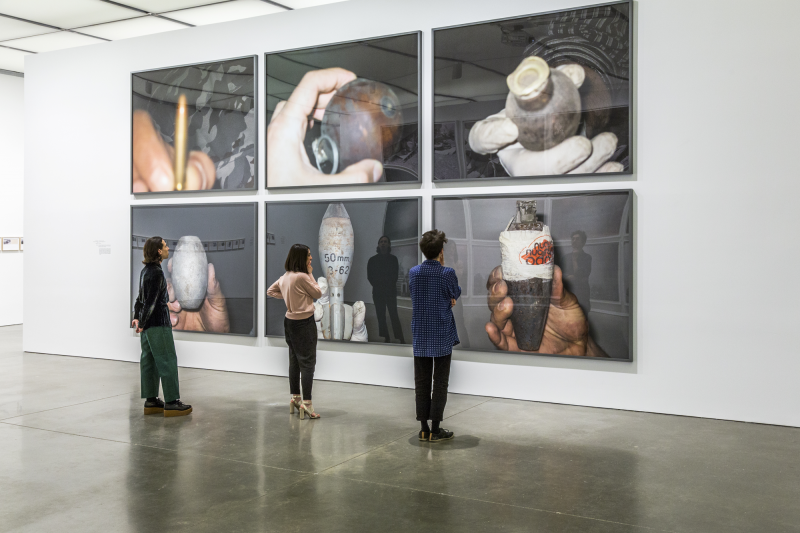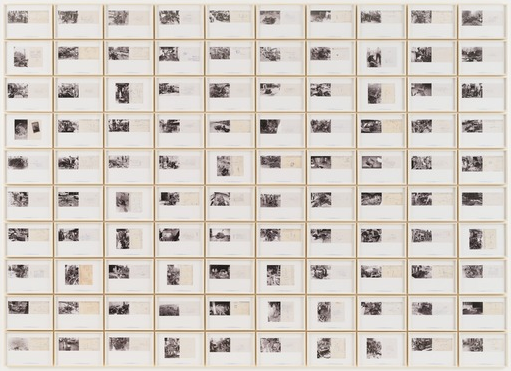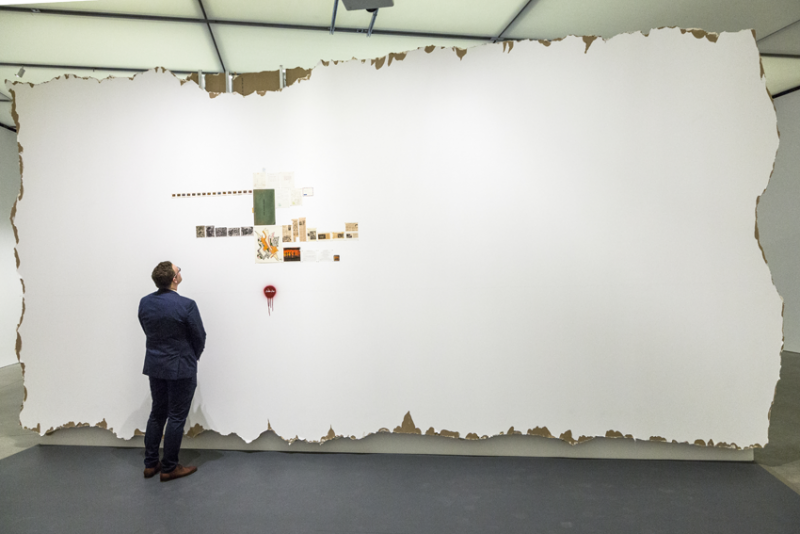by David Martinez
Walid Raad is currently at the ICA in Boston showing a series of group works titled Scratches On Things I Could Disavow and The Atlas Group. The ICA states:
This exhibition will be the first comprehensive North American museum survey of the internationally recognized artist Walid Raad (b. 1967, Lebanon), whose work in photography, video, sculpture, and performance in the last 25 years investigates the distinctions between fact and fiction and the ways we represent, remember, and make sense of history.
The work explores photographic documents and the role of memory and narrative within discourses of conflict. It brings attention to the histories of art in the Arab world with Raad bringing in references to his upbringing in Lebanon during the civil war (1975–1990).
When I first approached the entrance to the gallery at the ICA, the front desk informed me of the importance of the guided 55-minute presentation, Walkthrough, a recording available on the ICA Mobile Guide. The ICA strongly encourages visitors to access this walkthrough which offers a deeper understanding of the work on view and a chance to hear directly from the artist. My current opinion on these guided tours is that the recordings serve as a one-way street to understanding the work and instantly getting what the work was about, a cheat sheet to very complicated works of art — the fact that one should know about the history of civil war in Lebanon or understand Arabic potentially restricts the audience. Incorporating Walkthough opened up that opportunity for outsiders to understand the work but it was handed to them, breaking down the constriction, the meaning, and the visual symbols of each piece in the gallery. For viewers it was an experience to get to to know the artist but personally I’d like to get to know the art first.
Pieces such as Index XXXVI: Red, pictured above, features a striking installation and vivid key symbols to the visual interpretation of the piece. A list of names is lightly inscribed into the wall with a very piercing red paint highlighting one of the names, drawing your attention to the documented text above. Without the audio tour, it was interesting to ponder on its meaning and concept. I found my eyes being directed throughout the installation in a stepped manner. One clue led to the next, summing up the visual language.
The walkthrough made the work lose its striking power. It held the viewer’s hand as it guided them through an audio recording of Raad explaining his process and his epination for the red. He spoke very genuinely about his process as if he was having a one on one conversation with the person listen to his audio. Sometimes little is more and allowing the audience to get the piece on their own would have been a better route to take with this specific piece.

A piece that the audio enhanced was I might die before I get a rifle, in The Atlas Group. At first glance, this piece without the audio looked like a list of images that documented different types of explosives and automatic weapons. Without the audio, I wouldn’t have known that Raad actually knew the names of every single explosive and the specific sound it made when it was incoming and when it hit. He knew the damage that each one would create and his memory was jolted to remember these devices of mass destruction, war, and violence. The trauma connected to being able to determine each explosive — due to the many Raad was exposed to — was unsettling for me as a viewer to even imagine how terrifying those moments must have been for Raad to experience.
Another piece in The Atlas Group that stood out was My neck is thinner than a hair: Engines. The work assembles one hundred photographs of car engines taken by amateur and professional photographers. During the civil wars, approximately 245 car bombs exploded in Lebanon, detonated by groups across the political and religious spectrum. The only part of the car that remained intact after the blast was the engine; newspaper reports of car bombs consistently included photographs of engines and the police officers, politicians, and onlookers who gathered in the aftermath of the explosion. Raad collected the photographs from newspaper archives in Lebanon, scanned their fronts and backs, and printed them with the date of the explosion, the name of the photographer (when known), and an English translation of the notations on the backs of the pictures. From a complex political issue he extracts and clarifies one aspect: the photo opportunity. This is just one lens through which Raad examines the ways in which the economic, political, and social history of Lebanon has been recorded, recalled, and understood. Bringing the scans into a gallery setting elevates them and makes each of the hundred photographs stand out as a moment frozen in time.

While some pieces really needed a deeper explanation to further understand the work, others needed nothing more but the audience standing in front of the work reflecting on what they are seeing. Assuming that the audience isn’t smart enough to understand distracts from the wanting to interact with the work. However, my take-back from this show is the awareness that it brings to the events occurring in Lebanon at that time. This show allowed me to walk away with new information, which for me, marks a successful show.
Walid Raad is on view at the ICA/Boston through May 30, 2016.
ICA Boston
100 Northern Avenue, Boston, MA | 617.478.3100
Open Tuesday, Wednesday, Saturday, and Sunday 10am–5pm, Thursday and Friday 10am–9pm. General admissions: $15; seniors: $13, students: $10, ICA members and youth under 17 are free.
Editor’s Note:
Jaime Gaiti and David Martinez are both seniors graduating from Maine College of Art this spring. As members of the Senior Curatorial Team, they have worked collaboratively this semester on developing their BFA Thesis Exhibition, In Sensorium. Their work in this issue of The Chart is part of a partnership with Christopher Patch’s curatorial class to investigate and respond to curatorial decisions in museums and institutions in an effort to inform the students’ own choices throughout In Sensorium and beyond.
In Sensorium is a four-part exhibition of thesis works from the 2016 graduating senior class at Maine College of Art. Each section examines the use of different materials, identities, processes and visual languages through four distinct themes: render, arrive,disturbance, and vivid. The exhibition showcases work from eleven disciplines across three floors of the Porteous building at 522 Congress Street and two adjacent galleries. This collection of exploratory concepts and innovative designs culminate in a full sensorium of experience.
In Sensorium is on view Friday, April 29 through Saturday, May 21, 2016. Opening Reception is Friday, May 6, 2016. Admission is free. For more information, visit meca.edu/index2016
A graduate of Maine College of Art, David Martínez is a sculptural artist focusing on the topics of child development and how certain instances in a child’s upbringing can affect their outcome as an adult. Born and raised in Stamford, Connecticut, the big city of Manhattan, New York, was easily accessible. Growing up around such a large city, along with having a rich Hispanic background, David is highly influenced by the urban life and its affects on his upbringing as a child. His overall goal is to open up discussion and to raise awareness through his art making.

